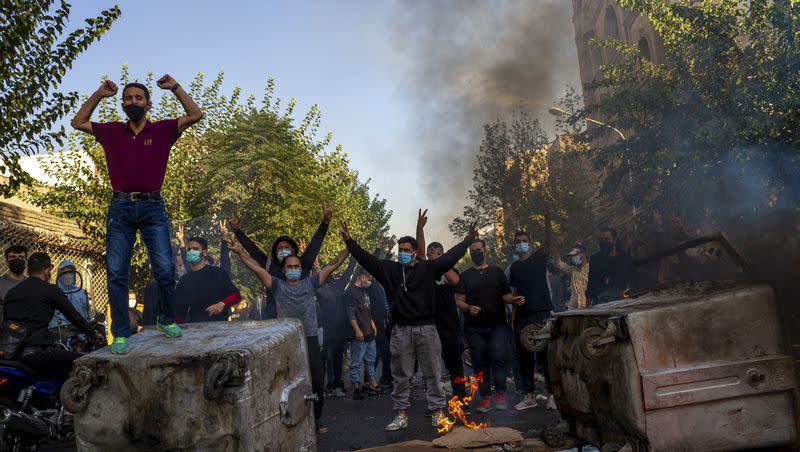Opinion: Poisoned schoolgirls, jailed journalists. The fight against censorship in Iran continues

For the past 44 years, the Iranian government has been one of the most egregious abusers of the rights of professional and citizen reporters around the world. Yet these journalists have continued to play a crucial role in tracking abuses in Iran, most recently concerning the treatment of women. Using a variety of platforms from WhatsApp to Instagram and Clubhouse, they have managed to bypass government censorship, sharing information about government attacks on peaceful protesters and the intentional poisonings of schoolgirls.
Being a journalist and reporting the truth in Iran carries a hefty price. Reporters Without Borders states that Iran is now “the world’s third biggest jailer of journalists,” following China and Myanmar. According to the Committee to Protect Journalists, more than 80 journalists have been arrested since the outbreak of protests in September 2022. The real numbers could be much higher. Iranian security forces have specifically targeted female journalists, a reflection of the leading role of women in the protest movement. At least 40 female journalists have been arrested.
The coverage by three female journalists brought world attention to the spontaneous protests over the death of Mahsa Amini that began in September 2022 and continue today. Niloofar Hamedi was the first journalist to report on Amini falling into a coma after beatings by the Iranian morality police. Elahe Mohammadi covered Amini’s funeral in Saqqez, in the province of Kurdistan, reporting on the large crowd of protesters chanting “Death to the dictator” and “Women, Life, Freedom.” Another reporter, Nazila Maroofian, released an online interview with Amini’s father disputing the government’s claim that his daughter died from health issues unrelated to her arrest. Her article was titled “They Are Lying.” These journalists gave voice to voiceless parents and young women witnessing and experiencing the pain of victimization and discrimination.
Related
The government arrested these three journalists, harassed their family members, and accused them of collaborating with Western intelligence services. They are now in prison with more than 40 other journalists. On Feb. 5, 2023, Mohammadi’s sister, Elnaz, a journalist for the daily Ham-Mihan newspaper, was also arrested. Although another 25 journalists have been released on bail, they remain under surveillance.
When the government imprisons professional journalists, citizen reporters step up their efforts in order to fill the void. Since the government of Iran makes it extremely difficult for foreign reporters to enter the country, citizen reporters, some living in even the most remote towns, use social media and Persian-language outlets. Iran International has provided extensive coverage of the protest movement, relying on hundreds of reports, videos and still images sent by citizen journalists.
Some of these images have become iconic — street scenes of women burning their headscarves while dancing around bonfires, an elderly woman with white hair marching and chanting “Death to Khamenei,” and schoolgirls singing protest anthems, proudly displaying their long hair. Like spotlights on a stage, citizen reporters direct attention to the protests, keeping Iranians and the international community informed of what the government wants hidden.
In addition to reporting on the street protests, journalists have covered the poisoning of schoolgirls in over 90 schools across 20 provinces beginning in November 2022. More than 2,000 high school students have been poisoned, according to data from the Iranian daily Etemad Online.
At first, government agencies and their news outlets attributed the illnesses to “poor hygiene,” “stress,” or “deception by students (wanting) to skip school.” Yet journalists persisted, some calling it “serial poisoning,” others referring to it as “biological terrorism.” Citizen reporters videoed parents arriving at schools and frantically searching for their children; one journalist recorded a plainclothes official assaulting a mother. A journalist for Qum Daily, Ali Pour Tabatabai, has been arrested for his reports concerning the poisoning cases, and the daily Etemad Online has been warned not to pursue the stories any further.
With evidence mounting, the Iranian Teachers Trade Association issued a call to action, demanding accountability from the government and urgent action. Their statement pointed the finger of guilt to religious extremists, who have increasingly been given free rein by the government. Reluctantly, government officials acknowledged that schoolgirls were being deliberately poisoned but were unable to catch the extremists. Reporters sardonically questioned why the regime’s sophisticated surveillance cameras can identify women without headscarves, but not the perpetrators of gas attacks on school children. Likely, the miscreants want to create an atmosphere of fear to discourage women from joining the protests.
In the midst of the regime’s war against reporters, schoolchildren and peaceful protesters, brave professional and citizen journalists in Iran keep the world informed about the deteriorating political and economic situations, human rights violations, and brutality of the regime’s repressive apparatus. Without Iranian professional journalists and citizen reporters, we would not know the magnitude and scope of the Iranian regime’s brutality. They have played a pivotal role in connecting, informing and motivating Iranians to fight for a better future.
Bahman Baktiari is the executive director of the Baskerville Institute.

